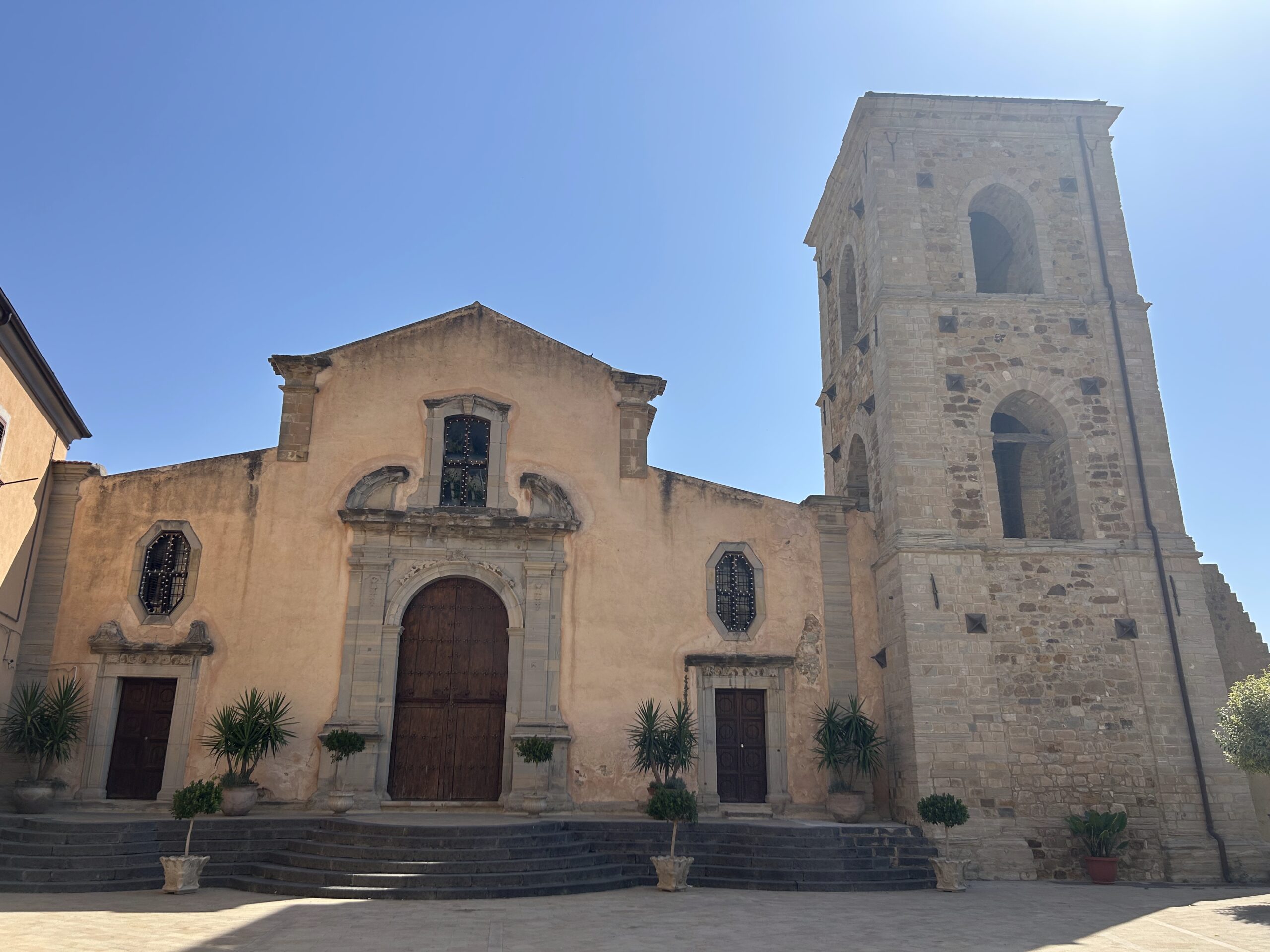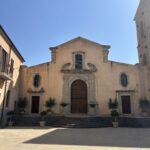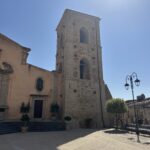Italiano
 Chiesa S. Michele Arcangelo
Chiesa S. Michele Arcangelo. La Chiesa è fra le più antiche di Nicosia, secondo alcuni preesisteva all’arrivo dei Normanni, ma con molta probabilità fu eretta come priorato benedettino dal Conte Ruggero, come menziona un diploma del 1134. Oggi la chiesa non si presenta nella magnificenza di chiesa normanna, ma nei moduli quattrocenteschi, triabsidata, con un’elegante cornice che alleggerisce la muratura. La facciata risale al Settecento ed era in bugnato di pietra rustica, ma attualmente si presenta ricoperta di intonaco, mentre nella parte posteriore la facciata in bugnato di pietra e la splendida triabside che si eleva sulla nuda roccia. La chiesa è affiancata da una torre campanaria, sorta in epoca normanna, ma ricostruita nella forma attuale nel ‘400. Da circa un ventennio, i suoi tre piani alleggeriti da finestre a sesto acuto, sono ingabbiati ed occultati da tubi d’acciaio e legno per consolidare provvisoriamente la struttura. L’interno, di struttura gotica a tre navate e dieci colonne in pietra bianca, conserva un soffitto a capriate e tre statue di grande valore: il S. Michele in marmo, attribuito ad Antonello Gagini e due statue lignee di Stefano Li Volsi, S. Luca Casale e S. Michele. Quest’ultima statua è quella che viene portata in processione il Lunedì dopo Pasqua, Lunedì dell’Angelo. Sul catino absidale si trovava il Cristo Pantocratore, dipinto in epoca tardo-normanna, ridipinto nel ‘700 e pesantemente restaurato nel ‘900, definitivamente scrostato e cancellato in seguito al terremoto del 1967. Fra i quadri meritano rilievo la tela di S. Francesco e di S. Chiara di ignoto autore del Seicento. Per la redazione del testo è stata adoperata la seguente bibliografia: Contino N., Nicosia, Guida storico-turistica. Ass. Pro Loco, Nicosia 1990; Di Cataldo A., Nicosia alla riscoperta della città. L’antico quartiere di San Michele Arcangelo tra vie, vicoli, chiassi e cortili, Assoro (En) 2008; Gioco S., Nicosia Diocesi. Scuola Salesiana del Libro, Catania 1972.
English
 Church of St. Michele Arcangelo.
Church of St. Michele Arcangelo. The church is one of the oldest in Nicosia. According to some, it existed before the arrival of the Normans, but it was most likely built as a Benedictine priory by Count Ruggero, as mentioned in a diploma dated 1134. Today, the church does not have the magnificence of a Norman church, but rather a 15th-century style, with three apses and an elegant cornice that lightens the masonry. The façade dates back to the 18th century and was originally rusticated stone, but is now covered with plaster, while the rear façade is rusticated stone and the splendid triple apse rises above the bare rock. The church is flanked by a bell tower, built in the Norman era but rebuilt in its current form in the 15th century. For about twenty years, its three floors, lightened by pointed windows, have been caged and concealed by steel and wooden tubes to temporarily consolidate the structure. The interior, with a Gothic structure with three naves and ten white stone columns, preserves a trussed ceiling and three statues of great value: St. Michael in marble, attributed to Antonello Gagini, and two wooden statues by Stefano Li Volsi, St. Luke Casale and St. Michael. The latter statue is carried in procession on the Monday after Easter, known as Easter Monday. The apse basin once housed Christ Pantocrator, painted in the late Norman period, repainted in the 18th century and heavily restored in the 20th century, before being completely stripped and erased following the 1967 earthquake. Among the paintings, the canvas of St. Francis and St. Clare by an unknown 17th-century artist is particularly noteworthy. The following bibliography was used in the preparation of this text: Contino N., Nicosia, Historical-Tourist Guide. Ass. Pro Loco, Nicosia 1990; Di Cataldo A., Nicosia: Rediscovering the City. The ancient district of San Michele Arcangelo among streets, alleys, lanes and courtyards, Assoro (En) 2008; Gioco S., Nicosia Diocese. Salesian School of the Book, Catania 1972.
Deutsch
 Kirche von Hl.Michele.
Kirche von Hl.Michele. Die Kirche gehört zu den altesten von Nicosia,nach einigen Vorbestehen bei der Ankunft der Normannen,aber höchstwahrscheinlich wurde sie als Benediktinerpriorat vom Grafen Roger errichtet,als er ein Diplon von 1134 erwähnt.Heute erscheint die Kirche nicht in der Pracht der normannischen Kirche,sondern im 400 Jahrhundert,Triabsidata-Module,mit einem eleganten Rahmen,der das Mauerwerk hellt.Die Fassade stammt aus dem 700 Jahrhundert und war rustizierter Quader,aber ist jetzt mit Gips bedeckt,während im hinteren Teil der Stein Quader Fassade und die schöne Triabside,die auf dem kahlen Felsen steigt. Die Kirche wird von einem Glockenturm flankiert,der in der normannischen Zeit erbaut wurde,aber in seiner jetzigen Form im Jahr 400 wieder aufgebaut wurde.Seit etwa zwanzig Jahren sind die drei durch spitzbogige Fenster erhallten Stockwerke von Stahl und Holzpfeifen für vorübergehend konsolidieren die Struktur. Das Innere,gotischer Struktur mit drei Seiten und zehn Säulen aus weißem Stein,bewahrt eine Decke aus Caprizet und drei Statuen von großem Wert:die Marmor-Michele aus Marmor,die Antonello Gagini zugeschrieben wird,und zwei Holzstatuen von Stefano Li Volsi,Hl.Luca Bauernhaus und Hl.Michele. Diese letzte Statue ist diejenige,die am Montag nach Ostern,am Montag des Angelo,in Prozession getragen wird.Auf dem Apsisbecken befand sich der Christuspantokrator,der in der späten normannischen Zeit gemalt,700 neu gestrichen und 900 stark restauriert,nach dem Erdbeben von 1967 endgültig gekratzt und abgebrochen wurde. Unter den Gemälden verdienen die Leinwand des heiligen Francesco und von Hl.Chiara von einem unbekannten Autor sechshunderte Jahrhunderts besondere Aufmerksamkeit. Zur Aufbereitung des Textes wurde folgende Literaturliste verwendet: Contino N.,Nicosia,Guida storico-turistica.Ass.Pro Loco,Nicosia 1990: Di Cataldo A.,Nicosia alla riscoperta della citta.L’antico quartiere di San Michele Arcangelo tra vie,vicoli,chiassi e cortili,Assoro (En) 2008: Gioco S.,Nicosia Diocesi.Scuola Salesiana del Libro,Catania 1972. Die erzählende Stimme ist von Tina Vaccalluzzo.
Français
 Chiesa San Michele.
Chiesa San Michele. L’église est une des plus anciennes de Nicosia. Selond certains affirment qu’elle existait déjà avant l’arrivée des Normands. Mais, comme mentionné dans un certificat de 1134, il est plus probable que l’église fut bâtie comme un cloitre Bénédictin par Conte Ruggero. Aujourd’hui l’église ne profite plus de la beauté qu’elle avait pendant le période Normande. Maintenant elle a l’aspect d’une église du XVe siècle avec ses trois absides et un décor élégant qui a le but d’alléger sa structure. La façade remonte au XVIIIe siècle et était faite en bossage de pierre rustique, mais aujourd’hui elle se présente plâtrée. L’arrière de l’église a encore la façade en pierre rustique et une très belle abside qui se lève de la pierre. L’église se trouve à côté d’un clocher Normand, qui a pris sa forme actuelle au XVe siècle. Ses trois niveaux paraissent allégés grâce aux fenêtres en arc pointu. Elles sont comprises et cachées par des tubes en acier et bois, au fin de consolider et supporter la structure de façon temporaire. L’intérieur a une structure Gothique et présente trois nefs et dix colonnes en pierre blanche et un plafond à capriate. En plus, on y peut admirer trois statues très importantes: la statue en marbre de S. Michele de Antonello Gagini, deux statues en bois de Stefano Li Volsi: S. Luca et S. Michele. Cette dernière est celle portée en procession le Lundi de Pâques. Sur le bassin absidale, une fois il y avait un Cristo Pantocratore. Il a été peint pendant la fin de la période Normande, il a été repeint au XVIIIe siècle et lourdement restauré au XXe siècle. En 1967 il fut définitivement écrouté et enlevé après le tremblement de terre. Entre le peintures on peut admirer ceux de S. Francesco et de S. Chiara qui datent du XVIIe siècle mais dont on ne connait pas l’auteur. Pour la rédaction du texte la bibliographie suivante a été utilisée: Contino N., Nicosia, Guida storico-turistica. Ass. Pro Loco, Nicosia 1990; Di Cataldo A., Nicosia alla riscoperta della città. L’antico quartiere di San Michele Arcangelo tra vie, vicoli, chiassi e cortili, Assoro (En) 2008; Gioco S., Nicosia Diocesi. Scuola Salesiana del Libro, Catania 1972
Español
 Iglesia de S. Michele Arcangelo.
Iglesia de S. Michele Arcangelo. La Iglesia es una de las más antiguas de Nicosia, según algunos existía antes de la llegada de los normandos, pero probablemente fue erigida como un priorato benedictino por el Conde Roger, como se menciona en un diploma con fecha de 1134. Hoy en día, la iglesia no aparece en la magnificencia de una iglesia normanda, sino en las formas del siglo XV, triapsas, con un marco elegante que ilumina la mampostería. La fachada se remonta al siglo XVIII y estaba en sillería de piedra rústica, pero actualmente está cubierta con yeso, mientras que en la parte posterior la fachada está en sillería de piedra y el espléndido borde de la ladera que se levanta sobre la roca desnuda. La iglesia está flanqueada por un campanario, construido en la época normanda, pero reconstruido en su forma actual en el siglo XV. Durante unos veinte años, sus tres pisos, iluminados por ventanas puntiagudas, han sido enjaulados y ocultos por tuberías de acero y madera para consolidar temporalmente la estructura. El interior, con una estructura gótica con tres naves y diez columnas de piedra blanca, conserva un techo enrejado y tres estatuas de gran valor: el mármol San Miguel, atribuido a Antonello Gagini y dos estatuas de madera de Stefano Li Volsi, S Luca Casale y S. Michele. Esta última estatua es la que se lleva en procesión el lunes después de Pascua, el lunes de Pascua. En el ábside estaba el Cristo Pantocrátor, pintado a finales del período normando, repintado en el siglo XVIII y restaurado en gran medida en el siglo XX, desechado y cancelado permanentemente después del terremoto de 1967. Entre las pinturas, merecen una mención especial la pintura de S. Francesco y S. Chiara de un autor desconocido del siglo XVII. Se ha utilizado la siguiente bibliografía para la preparación del texto: Contino N., Nicosia, guía histórico-turístico. Asociación Pro Loco, Nicosia 1990; Por Cataldo A., Nicosia para redescubrir la ciudad. El antiguo distrito de San Michele Arcangelo entre calles, callejones, ruido y patios, Assoro (En) 2008; Juego S., Nicosia Diócesis. Escuela Salesiana del Libro, Catania 1972.







